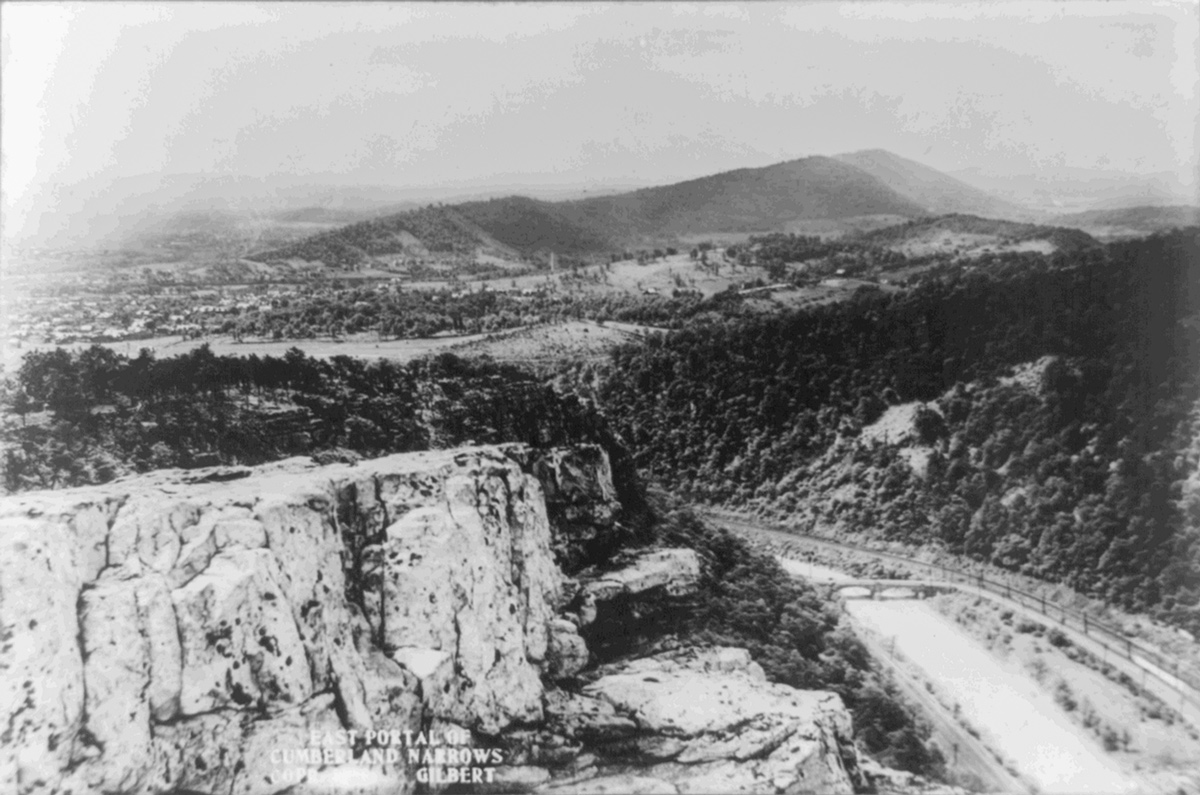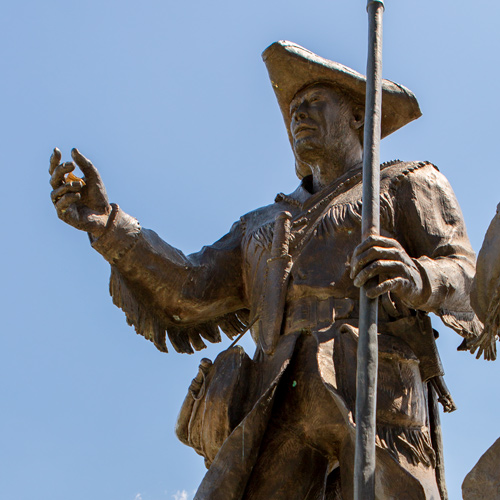TEST: Traveling from Harpers Ferry to Pittsburgh, Lewis turns west at Cumberland, Maryland and follows Nemacolin’s Trail through a gap in the Allegheny Mountains. The “Shades of Death” must also be passed.
In Washington City, President Jefferson writes to Lewis informing him of some items that Lewis left behind.
East portal of Cumberland Narrows, Maryland
Photograph by “Gilbert” c. 1918. Courtesy U.S. Library of Congress, www.loc.gov/pictures/item/2002716476/.
The Shades of Death
As he travels between Harpers Ferry and Pittsburgh, Lewis likely reminisced of travel here as a young officer in the Whiskey Rebellion. Fellow officer Robert Wellford gives this description of a mountain crossing between Fort Cumberland and Grantsville, Maryland.
24th.
From Strickers the Army proceeded this day to Tomlinson’s, at the little Meadows, 11 miles. the course of this day’s march led the Army over a thousand times ten thousand rocks, thro’ a dark, dreary part of the Mountains called the “Shades of Death,” & by an almost continued ascent to that rugged and elevated part of the Alleghany Mountains known by the epithet of the “back bone of America.” Towards evening it began to rain, and the Tents of the Cavalry were pitched in the right hand meadow directly opposite the former encampment of General Braddock, and the ground which Washington made a stand after Braddock’s defeat, the marks of which are now easily dicernable. The infantry & the Artillery fixed their temporary residence in the edge of the woods above the little meadows, which are in the State of Maryland. The rain increased during the evening, & the whole of the night.
—Robert Wellford[1]Ibid, p. 11.
Meriwether Lewis with Dirk
Statue by Robert M. “Bob” Scriver
© 2015 by Kristopher K. Townsend. Permission to use granted under the Creative Commons Attribution-Share Alike 4.0 International license.
Forgotten Items
Washington July 11. 03
Th: Jefferson to Capt. Lewis
I inclose you your pocket book left here. if the dirk will appear passable by post, that shall also be sent, when recieved. your bridle, left by the inattention of Joseph in packing your saddle, is too bulky to go in that way. we have not recieved a word from Europe since you left us. be so good as to keep me always advised how to direct to you. accept my affectionate salutations & assurances of constant esteem.[4]Thomas Jefferson to Meriwether Lewis, Founders Online, National Archives, founders.archives.gov/documents/Jefferson/01-41-02-0006 accessed 12 June 2022. [Original source: The Papers of Thomas … Continue reading
Figure:
At his right hip Lewis carries his shot pouch and powder horn. Around his neck is slung the knife he probably called a dirk, which was not only a practical tool but also a defensive weapon. As with all the rest of the Corps since leaving Fort Mandan, he is clad in buckskin. Historical research since the onset of the bicentennial observance has shown that the tricorn hat he wears here was officially replaced with new styles of headgear before the expedition began.
—Robert R. Hunt in Espontoons
Lewis likely carried a dirk made at the Harpers Ferry armory.
Experience the Lewis and Clark Trail
The Lewis and Clark Trail Experience—our sister site at lewisandclark.travel—connects the world to people and places on the Lewis and Clark Trail.
Plan a trip related to July 11, 1803:
- Harpers Ferry to Brownsville (Inspiration Trip)

Notes
| ↑1 | Ibid, p. 11. |
|---|---|
| ↑2 | John Kennedy Lacock, The Pennsylvania Magazine of History and Biography 38, no. 1 (1914): 17–18. |
| ↑3 | Fred Anderson, Crucible of War: The Seven Years’ War and the Fate of Empire in British North America, 1754–1766 (New York: Alfred E Knopf, 2000), 103–4. |
| ↑4 | Thomas Jefferson to Meriwether Lewis, Founders Online, National Archives, founders.archives.gov/documents/Jefferson/01-41-02-0006 accessed 12 June 2022. [Original source: The Papers of Thomas Jefferson, vol. 41, 11 July–15 November 1803, ed. Barbara B. Oberg. Princeton: Princeton University Press, 2014, p. 11.] |


